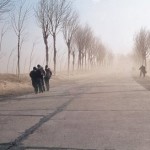China Beat writes about Beijing Sixty-Six, an exhibit of photographs of the beginning of the Cultural Revolution taken by Solange Brand:
Solange Brand was 19 or 20 years old, the same age as these young Red Guards, when she was sent to work as a secretary at the French Embassy in Beijing. Unknowingly, with her Pentax she captured the beginning of the Great Cultural Revolution.
What, with indescribable emotion, the Chinese photographers in Pingyao saw was perhaps a “self-projection” or “self-identification” with the faces of these young men and women, even children, who could have been themselves from a long lost memory.
Here lies the power of photography: What the Chinese viewers experience is like taking a swab of reality—an operation of “cut and paste”—and transposing it to fill in the void in our imaginations, to fill in the empty place in our collective memory, to fill in the absence as in our absentmindedness. We are confronted again by Roland Barthes’ famous “Ça a été—that has been.” Photography’s immediacy acts to set up an instantaneous observation of the experience of its author. As a result of the cut and paste, this transposition becomes an affirmation of “I have seen this” or “I have been there.” Hence the excitement we feel in the possibility of scrutinizing each face in the crowd and asking of ourselves: Was that how we looked at that time?










